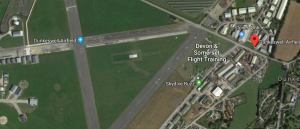Monday Accidents & Lessons Learned: UK Crash Reveals Use of Mogas & a Vapor Lock

A February 14, 2019, Air Accidents Investigation Branch (AAIB) published report regarding a UK aviation incident informs us that the aircraft involved was running on fuel not approved for aviation use, and that the pilot sent out a Mayday signal moments before touchdown after the engine suddenly cut out without warning. Let’s look further into the circumstances leading up to and during the incident.
A few minutes after 12:30 p.m., July 7, 2018, a light aircraft–a modified Rutan Long-Ez G-WBPWP plane–crashed into a field near Dunkeswell Airport; the occupants were the 80-year-old pilot, also the owner of the aircraft, and a passenger.
Following the crash, a police cordon was put in place at Dunkeswell Airfield. Subsequently, the Department for Transport’s AAIB announced it was sending investigators to the scene to look into the cause of the incident. Fire crews from surrounding towns were called to the scene along with paramedics, police, and ambulances.

What happened
The pilot was operating his aircraft with a mixture of automotive gasoline (Mogas) and aviation gasoline (Avgas) 100LL in the left fuel tank and Avgas 100LL in the right fuel tank. While on its base leg to land on runway 4 at Dunkeswell Airfield, the aircraft’s engine, which was being supplied with fuel from the left fuel tank, suddenly stopped. The pilot established a glide to land in a field in the undershoot, but at a late stage in the approach he spotted a fence running across his chosen landing site. While maneuvering to avoid the fence, the aircraft touched down hard, seriously injuring the pilot; the passenger sustained minor injuries. Upon touchdown, the airplane traveled along the ground for approximately 187 feet before coming to a standstill.
The likely cause of the engine stopping was either carburetor icing or a vapor lock in the aircraft fuel supply to the engine.
Background
The pilot and his passenger planned to fly from Biggin Hill Airport to Dunkeswell Airfield. The aircraft departed at 10:13 a.m., with the right fuel tank selected and about 20 gallons of fuel on board. The flight progressed through southern England without event, during which time the pilot selected the left fuel tank when the right tank indicated about 6 gallons. The fuel selector remained in this position for the rest of the flight.
The AAIB report states, “Following the engine failure, the pilot would have been faced with a steeper than normal glide approach and most likely did not arrest the high rate of descent sufficiently before the aircraft touched down firmly.”
You may read the full AAIB report here.
Circumstances can crop up anywhere at any time if proper and safe sequence and procedures are not planned and followed. We encourage you to learn and use the TapRooT® System to find and fix problems. Attend one of our courses. We offer a basic 2-Day Course and an advanced 5-Day Course. You may also contact us about having a course at your site.

Register for our upcoming 2019 Global TapRooT® Summit, March 11-15, 2019, in the Houston, Texas, area at La Torretta Lake Resort. You don’t want to miss a minute of the TapRooT® Summit!



